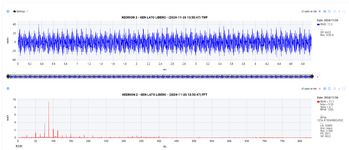Sofistioelevib
Industrial
Good morning to everyone,
some strange spectra today during analisys.
DIESEL TCG 2020 V16 (caterpillar) connected directly on MARELLI generator
Speed: 1500 RPM
I found about 87Hz as exactly 7 times firing frequency (1/2 RPM) till 10 mm/s as below

Lot of time i found some problem with firing but frequency was related exactly to cylinders number but in this case this frequency is like CYLINDERS -1 frequency and this is no sense for me.
Anyone had some experience like this? What suggestions from you in order to inspect better this component and find the origin?
Regards
some strange spectra today during analisys.
DIESEL TCG 2020 V16 (caterpillar) connected directly on MARELLI generator
Speed: 1500 RPM
I found about 87Hz as exactly 7 times firing frequency (1/2 RPM) till 10 mm/s as below

Lot of time i found some problem with firing but frequency was related exactly to cylinders number but in this case this frequency is like CYLINDERS -1 frequency and this is no sense for me.
Anyone had some experience like this? What suggestions from you in order to inspect better this component and find the origin?
Regards

